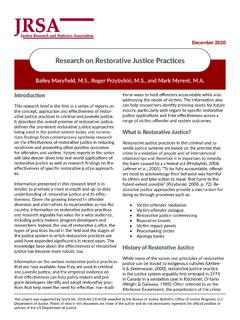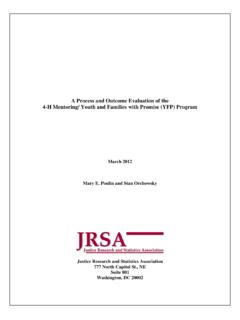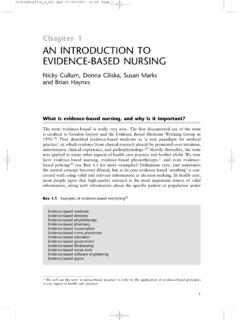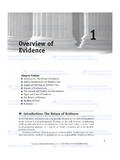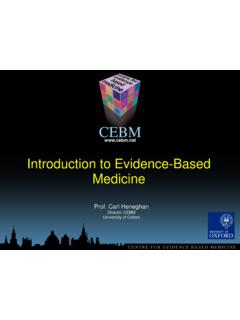Transcription of AN INTRODUCTION TO EVIDENCE-BASED PRACTICES
1 AN INTRODUCTIONTO evidence -BASEDPRACTICESAPRIL 2014 EXECUTIVE SUMMARYACKNOWLEDGMENTS is briefing was prepared by Stan Orchowsky, , Research Director for theJustice Research and Statistics Association. We wish to thank Tammy Woodhamsand our partners at the National Criminal Justice Association, and Lesley Buchanand Ed Banks at the Bureau of Justice Assistance. is project was supported by Award No. 2010-DJ-BX-K176 awarded by the Bureau of Justice Assistance, Office of Justice Programs, and Department of Justice. e opinions, findings and conclusions or recommendations expressed inthis publication/program/exhibition are those of the author(s) and do not necessarilyreflect the views of the Department of Justice. e movement toward the use of EVIDENCE-BASED PRACTICES (EBPs) has been sweeping thecriminal justice community in recent years. e purpose of this briefing paper is to provide poli-cymakers with an INTRODUCTION and overview of the key concepts and issues associated with theidentification and use of EBPs in criminal justice.
2 E briefing provides a brief history of the evi-dence- based movement, discusses what is meant by evidence and where evidence comes from,identifies sources for information on EBPs, discusses issues associated with implementing EBPs,and addresses the question of what to do when there is no evidence for a particular program Brief History of the EVIDENCE-BASED Movement Today s EVIDENCE-BASED movement has its origins in the field of medicine, beginning in themid-1800s. e Federal Food, Drug, and Cosmetic Act required that the safety and efficacy of newdrugs be demonstrated by scientific investigation before marketing was allowed. As recently as1976, a report to Congress concluded that only 10 to 20% of all procedures used in present med-ical practice have been proven by clinical trial; many of these procedures may not be efficacious. Shortly therea er, the medical community began assembling evidence on effective interventionsdrawn from rigorous studies and disseminating it in a way that practitioners could easily accessand criminal justice, the mid-1970s saw the publication by Robert Martinson of his now infa-mous synthesis of research in corrections (Martinson, 1974), followed by a book by Lipton, Mar-tinson, and Wilks (1975), both of which seemed to lead to the conclusion that nothing works inrehabilitating offenders.
3 In the 1980s, numerous reviews were conducted to rebut Martinson, alongwith research into the effectiveness of alternative ways of preventing Crime. In the mid-1990s, twodifferent efforts attempted to identify specific programs that were effective and to objectively assessthe methodological quality of each of the studies supporting conclusions about what works. In1996, the Center for the Study and Prevention of Violence (CSPV) at the Institute of BehavioralScience, University of Colorado Boulder developed the Blueprints for Violence Prevention, whichinitially identified 10 model programs for delinquency prevention and intervention that meet astrict scientific standard of program 1996, Congress mandated a "comprehensive evaluation of the effectiveness" of Departmentof Justice grants to assist state and local law enforcement and communities in preventing crime. e result was a highly visible effort to identify EBPs in criminal justice by reviewing research andevaluation studies carried out by Dr.
4 Lawrence Sherman and his colleagues at the University ofMaryland. e Maryland study was one of the first criminal justice efforts to score the evaluationEXECUTIVE SUMMARY| APRIL 20141AN INTRODUCTION TO EVIDENCE-BASED PRACTICES2 EXECUTIVE SUMMARY| APRIL 2014studies it reviewed based on the strength of the scientific methods Does evidence Come From? e Office of Justice Programs (OJP) considers programs and PRACTICES to be evidence - basedwhen their effectiveness has been demonstrated by causal evidence , generally obtained throughhigh quality outcome evaluations, and notes that causal evidence depends on the use of scientificmethods to rule out, to the extent possible, alternative explanations for the documented change. Incriminal justice, the term effectiveness usually means reducing crime (in the case of policing in-terventions), reducing recidivism (correctional interventions), or reducing victimization/revictim-ization (prevention/victim- based interventions).
5 E term scientific evidence is used to describe evidence that is: objective(observable by oth-ers, based on facts rather than thoughts or opinions, and free of bias or prejudice that might becaused by personal feelings; replicable(can be observed by others using the same methods thatwere used to produce the original evidence ); and generalizable(can be applied to individuals andgroups other than those who were involved in producing the original evidence ). e hallmark of the scientific method is experimentation. is means comparing two groups:those who receive the intervention (treatment group) and those who do not (control group). eoutcomes or measures of effectiveness of interest (for example, recidivism) are compared for thetwo groups to determine if they are in the hypothesized (expected) direction. e best way to en-sure the equivalency of the two groups is through random assignment; that is, individuals are as-signed to the groups by the researcher/evaluator in a random manner such that each person has anequal chance of ending up in the experimental or control group.)
6 Ese designs, known as random-ized controlled trials (RCTs), provide confidence that observed differences are due to the interven-tion, and reduce the likelihood that evaluators will falsely conclude that the intervention beingstudied is controlled trials (RCTs), are o en referred to as the gold standard for producingevidence. However, there are a number of questions in criminal justice that cannot be easily ad-dressed using RCTs. In cases where RCTs are not feasible, other methods of designing evaluationsmay be employed that provide some assurance that observed differences are due to the interven-tion under study and not other factors. ese designs, known as quasi-experimental designs, varyin terms of their level of sophistication and their ability to control for other possible differences be-tween the groups that might explain outcomes. evidence produced by quasi- experimental designsis not considered as strong or as compelling as evidence from evaluations may not manage to use quasi-experimental designs, but may rely on simpleAN INTRODUCTION TO EVIDENCE-BASED PRACTICESEXECUTIVE SUMMARY| APRIL 20143measurement of outcomes.
7 Using this type of non-experimental design does not allow observedoutcomes to be attributed to the intervention itself. us little weight would be given to any evi-dence of effectiveness produced by this type of assessment. ere are many types of information that might be collected in an evaluation that would notrise to the level of scientific evidence . In particular, opinions, testimonials, and anecdotes are notevidence of effectiveness in and of sources of information on EBPs handle the question of how the quality and quantityof evidence should be balanced differently. However, in recent years researchers and evaluatorshave focused less on single evaluations and more on examining the magnitude and consistency ofthe evidence produced by multiple studies of specific programs and initiatives. is can be done bya systematic review conducted by subject matter experts, or by using meta- analysis, a statisticalmethod for combining the results of multiple evaluation for Identifying EBPsIn criminal justice, the premier resource for identifying EBPs is ( ).
8 Established by OJP in 2011, provides informationon 270 programs in a number of areas of criminal justice including corrections, courts, crime andcrime prevention, drugs and substance abuse, juveniles, law enforcement, technology and forensics,and victims and victimization. Programs are rated as effective, promising, or no evidence . e Office of Juvenile Justice and Delinquency Prevention (OJJDP) established the Model Pro-grams Guide (MPG) in 2000. e MPG contains over 200 juvenile justice programs rated as either exemplary, effective, or promising. Ratings were established by a peer review panel, and arenow based on the same rating instrument used by e What Works in Reentry Clearinghouse ( ) is a BJA-funded initiative established by the Council of State Governments in 2012 and designed to provideinformation on EVIDENCE-BASED reentry interventions. e site contains information about 56 ini-tiatives in six focus areas (brand name programs, employment, family- based programs, housing,mental health, and substance abuse).
9 Interventions are rated on a five-point scale: strong or modestevidence of a beneficial effect; no statistically significant findings; and strong or modest evidence ofa harmful of the criminal justice arena, an important resource for EBPs is the Substance Abuseand Mental Health Services Administration s (SAMHSA) National Registry of evidence - basedPrograms and PRACTICES (NREPP). NREPP ( ) includes almost 300 inter-ventions in the areas of mental health and substance abuse treatment, substance abuse prevention,AN INTRODUCTION TO EVIDENCE-BASED PRACTICESand mental health promotion. Independent reviewers assess studies in each area on the quality ofresearch and on readiness for from this brief summary of available resources, we can see that different organizationsand agencies take different approaches to identifying EBPs. e Blueprints for Healthy Youth De-velopment website provides a list of 500 youth programs rated on at least one of six federal or pri-vate organization EBP websites, including and the OJJDP MPG ( ).
10 Implementing EBPsOne of the keys to being able to take advantages of resources that provide lists of EBPs is being ableto successfully implement the programs or PRACTICES . is is known as implementing with fidelity. Unfortunately, it is o en difficult to obtain details about the programs assessed on these is o en the case that a program cannot be adopted for use directly, but must be adaptedtofit a particular set of circumstances before it can be used. Most websites offer caution in adaptingEBP programs, advising that key program components should be implemented with , as noted previously, it can be difficult or impossible to identify which program elementsmust be implemented exactly and which can be changed (and how) without affecting recent years, knowledge about how best to implement programs and PRACTICES has been in-creasing rapidly. One of the leading organizations in this implementation science movement hasbeen the National Implementation Research Network (NIRN).




